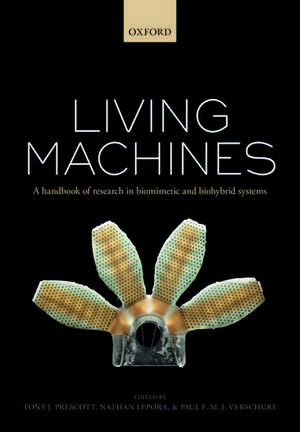Living machines: A handbook of research in biomimetics and biohybrid systems
Editat de Tony J. Prescott, Nathan Lepora, Paul F.M.J Verschureen Limba Engleză Hardback – 26 apr 2018
Preț: 1023.04 lei
Preț vechi: 1451.67 lei
-30% Nou
Puncte Express: 1535
Preț estimativ în valută:
195.76€ • 203.99$ • 162.09£
195.76€ • 203.99$ • 162.09£
Carte disponibilă
Livrare economică 03-08 martie
Preluare comenzi: 021 569.72.76
Specificații
ISBN-13: 9780199674923
ISBN-10: 0199674922
Pagini: 656
Dimensiuni: 178 x 253 x 35 mm
Greutate: 1.38 kg
Editura: OUP OXFORD
Colecția OUP Oxford
Locul publicării:Oxford, United Kingdom
ISBN-10: 0199674922
Pagini: 656
Dimensiuni: 178 x 253 x 35 mm
Greutate: 1.38 kg
Editura: OUP OXFORD
Colecția OUP Oxford
Locul publicării:Oxford, United Kingdom
Recenzii
Living machines is a fascinating overview of the current state of play across many and varied fields engaging in research about biometric and biohybrid systems and robotics ... It is beautifully produced.
The book's strength is its weaving together robotics and biology, with numbers used to compare the accuracy and capability of these systems... [I would] recommend this ambitious and useful work to anyone who is looking to be inspired by the future of biological robotics.
The book's strength is its weaving together robotics and biology, with numbers used to compare the accuracy and capability of these systems... [I would] recommend this ambitious and useful work to anyone who is looking to be inspired by the future of biological robotics.
Notă biografică
Tony Prescott is Professor of Cognitive Robotics at the University of Sheffield, UK, and Director of Sheffield Robotics, a cross-disciplinary research institute with over one hundred and fifty researchers (www.sheffieldrobotics.ac.uk). His background mixes psychology, neuroethology, and brain theory with robotics and artificial intelligence, and his research aims at answering questions about human nature by creating synthetic entities with capacities such as perception, memory, emotion, and sense of self. He is the co-creator of the mammal-like robots Scratchbot and Shrewbot, and is the co-founder of the UK company Consequential Robotics (www.consequentialrobotics.com ) that is developing assistive and companion robots including the animal-like robot 'pet' MiRo. He co-founded the International Living Machines conference series and also writes and speaks on societal and ethical issues in technology and the brain sciences.Nathan Lepora is a Senior Lecturer in Engineering Mathematicss at the University of Bristol, UK, and leads the Tactile Robotics Theme at Bristol Robotics Laboratory. His research interests span robotics, neuroscience, and biomimetics, focusing on the design of novel 3D-printed dexterous tactile robotic hands and sensors that can intelligently perceive, explore, and manipulate their environment. His team's research is supported by EPSRC and a Leverhulme Leadership Award, has won several international awards in robotics, and is on display in the Science Museum, London. He has authored over 60 academic publications, edited several proceedings, including three Living Machines conference volumes, and also written eight books for children on science and technology.Paul Verschure is a research professor with the Catalan Institute of Advanced Studies and Director of the Neuroengineering program at the Catalan Institute for Bioengineering. Paul trained in Psychology and his scientific aim is to find a unified theory of mind and brain using synthetic methods and to apply it to quality of life enhancing technologies. He has advanced a theory of mind and brain, Distributed Adaptive Control, which has led to a novel neurorehabilitation approach called the Rehabilitation Gaming System (eodyne.com). He also explores new methods for the exploration of complex data (brainx3.com) that is being tested on data from the human brain. Complementary to his science, Paul has developed and deployed over 25 art installations (http://specs.upf.edu/installations) from interactive spaces to BCI orchestras, robot Theremin soloists and virtual/augmented reality installations and tools for the holocaust memorial sites (futurememoryfoundation.org).
